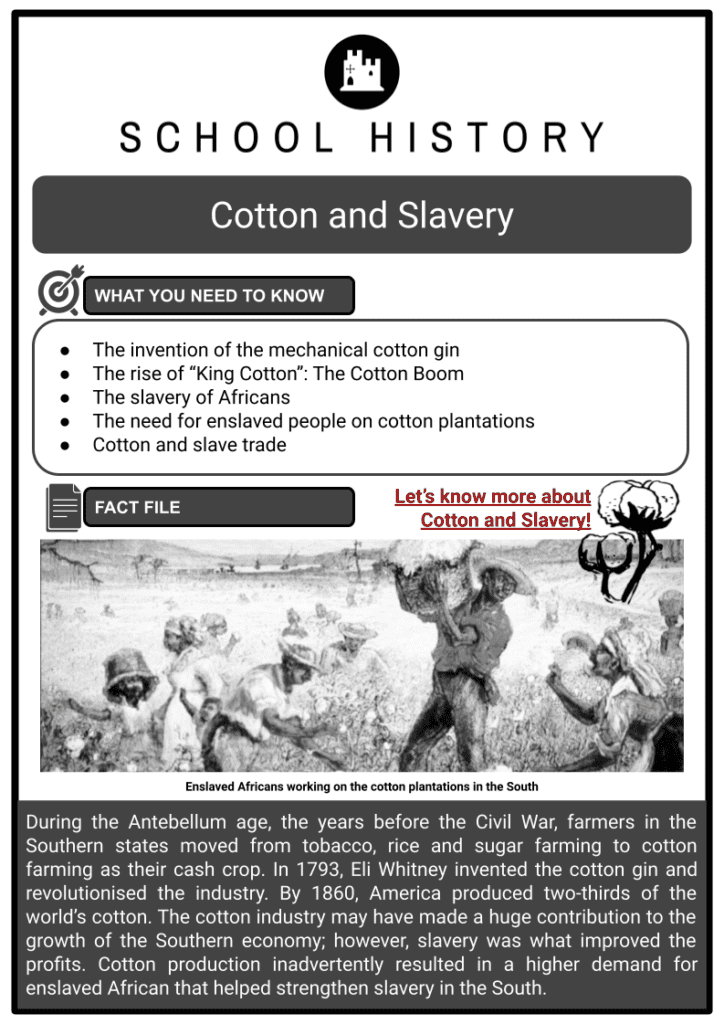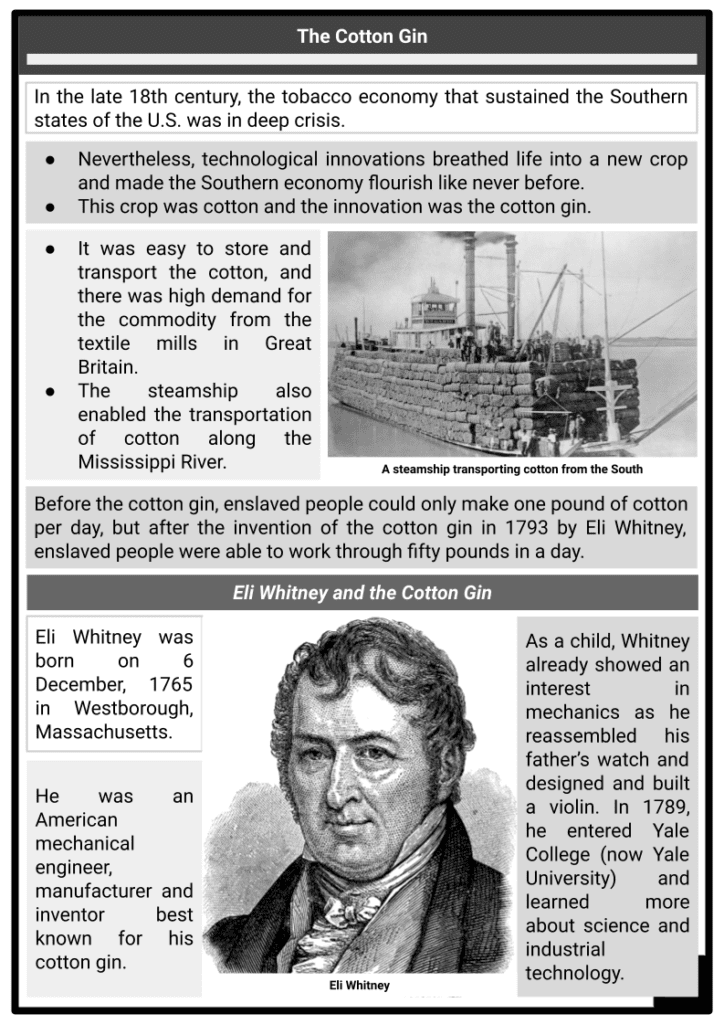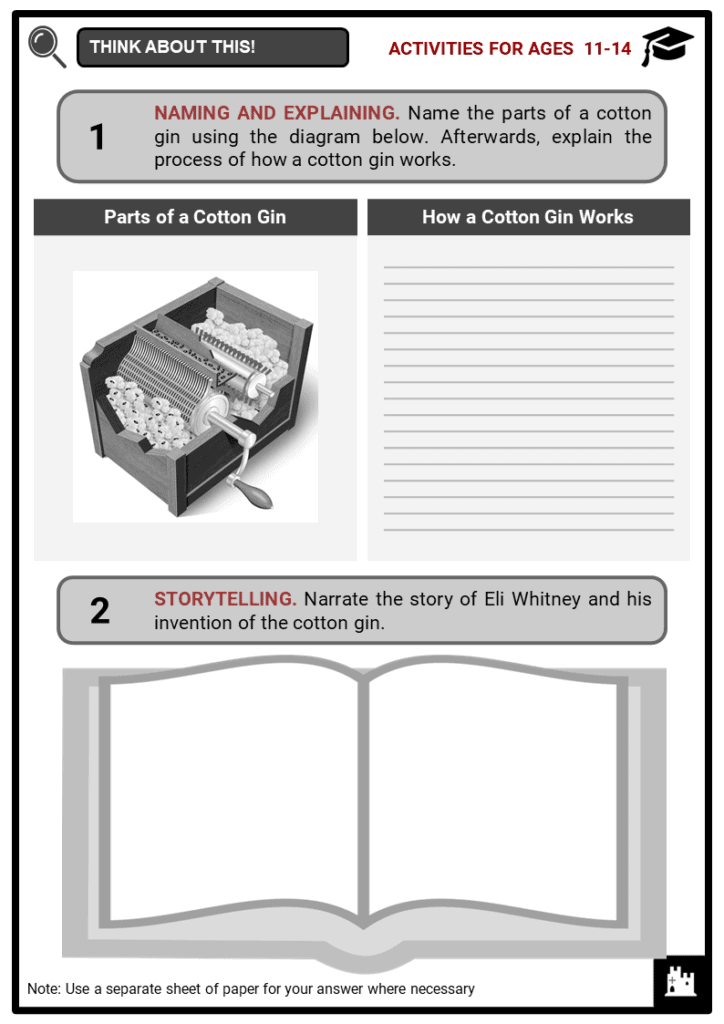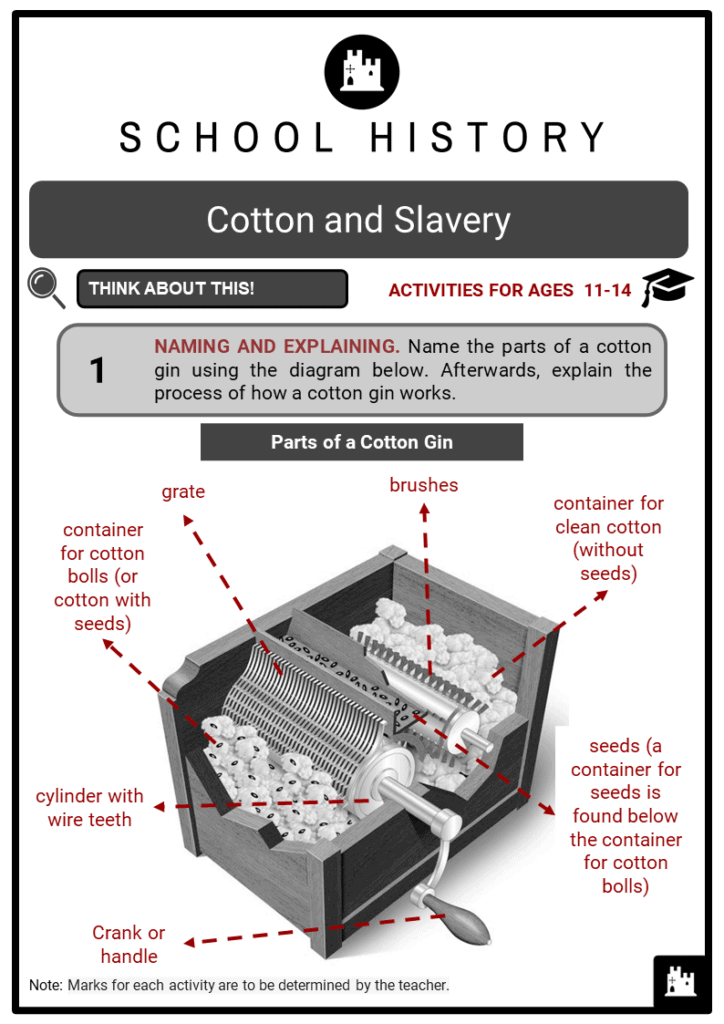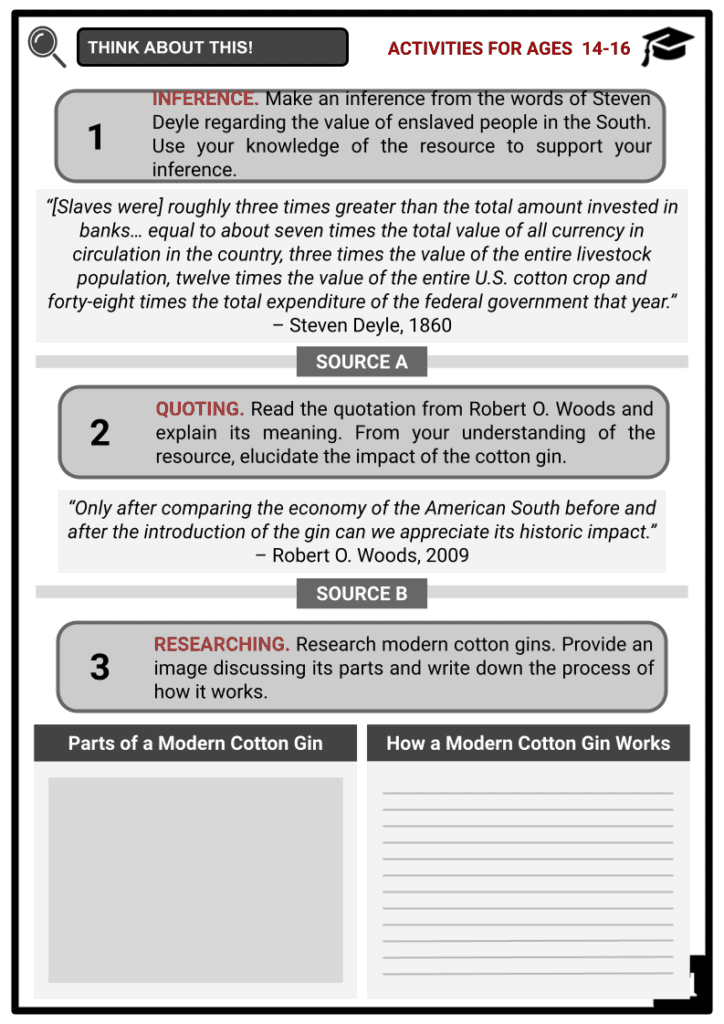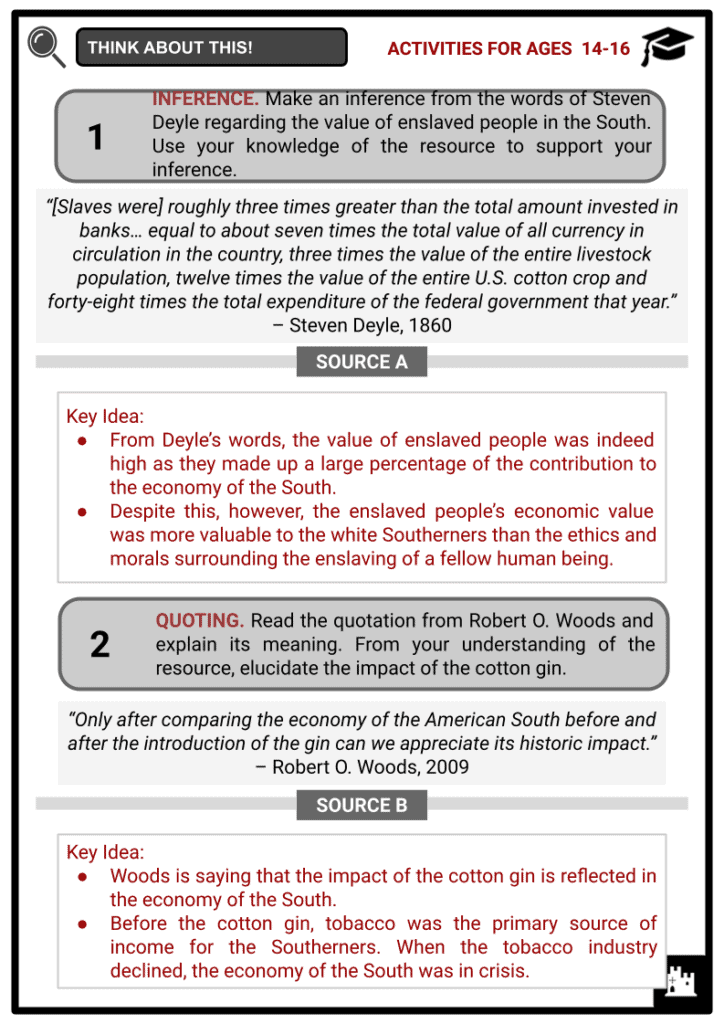Download Cotton and Slavery Worksheets
Do you want to save dozens of hours in time? Get your evenings and weekends back? Be able to teach Cotton and Slavery to your students?
Our worksheet bundle includes a fact file and printable worksheets and student activities. Perfect for both the classroom and homeschooling!
Table of Contents
Add a header to begin generating the table of contents
Summary
- The invention of the mechanical cotton gin
- The rise of “King Cotton”: The Cotton Boom
- The slavery of Africans
- The need for enslaved people on cotton plantations
- Cotton and slave trade
Key Facts And Information
Let's know more about Cotton and Slavery!
- During the Antebellum age, the years before the Civil War, farmers in the Southern states moved from tobacco, rice and sugar farming to cotton farming as their cash crop. In 1793, Eli Whitney invented the cotton gin and revolutionised the industry. By 1860, America produced two-thirds of the world’s cotton. The cotton industry may have made a huge contribution to the growth of the Southern economy; however, slavery was what improved the profits. Cotton production inadvertently resulted in a higher demand for enslaved Africans that helped strengthen slavery in the South.
The Cotton Gin
- In the late 18th century, the tobacco economy that sustained the Southern states of the U.S. was in deep crisis.
- Nevertheless, technological innovations breathed life into a new crop and made the Southern economy flourish like never before.
- This crop was cotton and the innovation was the cotton gin.
- It was easy to store and transport the cotton, and there was high demand for the commodity from the textile mills in Great Britain.
- The steamship also enabled the transportation of cotton along the Mississippi River.
- Before the cotton gin, enslaved people could only make one pound of cotton per day, but after the invention of the cotton gin in 1793 by Eli Whitney, enslaved people were able to work through fifty pounds in a day.
- Eli Whitney was born on 6 December, 1765 in Westborough, Massachusetts.
- He was an American mechanical engineer, manufacturer and inventor best known for his cotton gin.
- As a child, Whitney already showed an interest in mechanics as he reassembled his father’s watch and designed and built a violin. In 1789, he entered Yale College (now Yale University) and learned more about science and industrial technology.
- When he graduated, he headed South where he stayed at Catherine Greene’s plantation known as Mulberry Grove near Savannah, Georgia.
- Here, he learned about cotton production and how difficult it was for cotton farmers to make a living.
- Though cotton was an ideal crop as it is easily grown and can be stored for a long period of time (unlike food crops), it has stubborn seeds that are very difficult to separate from its fibres.
- After Greene explained the difficulty of cotton production to him, Whitney built a machine that could effectively remove the seeds from freshly picked cotton.

- He named the machine the cotton gin (“gin” came from “engine”).
- The cotton gin was patented in 1794 with the purpose of producing and installing gins throughout the South and making the farmers pay two-fifths of the resulting profit.
- With the simplicity of the machine, however, it became widely pirated as farmers created their own versions of the cotton gin.
- Whitney spent years in legal battles until he finally agreed to license the gins at an affordable rate.
- Though he created the cotton gin that revolutionised the economy of the South and made the Southerners rich, Whitney received little to no net profit from his creation.
- Eli Whitney might have been better known for his cotton gin but his most important contribution was the mass production of interchangeable parts.
The Benefits of the Cotton Gin
- The invention of the cotton gin was remarkable especially in the midst of the tobacco production crisis.
- Manually, an average cotton picker could only remove seeds of 10 pounds of cotton in a day.
- With the cotton gin, they could now process 100 pounds at the same time.
- That’s fifty times more than what a single person could do in a day.
Parts of a Cotton Gin
- The original design of the cotton gin was simple.
- It did not have the complex mechanisms that the modern cotton gin has today.
- Despite its simplicity, it served a great purpose during this time as it was able to separate the seeds from the cotton fibres faster than the human hand.
How a Cotton Gin Works
- Cotton containing seeds is dumped in a container for cotton bolls.
- The crank or handle, when turned, will rotate the cylinder with wire teeth.
- The close-knit design of the grate will allow the cotton fibres to pass through but not the seeds. The seeds are left and would work their way down eventually to their own container below the cotton bolls.
- The brushes pull the cotton from the grate.
- The cotton bolls are now turned into clean cotton without seeds and are placed in their respective container.
- It is in no doubt that Whitney’s invention gave rise to cotton production and an overwhelming demand for cotton cultivation using cheap labour.
The Cotton Boom and the Rise of “King Cotton”
- With the invention of the cotton gin, production and demand rose not only for cotton but also for slavery.
- By 1812, there was a considerable increase in cotton farming, called the Cotton Boom.
- Between 1801 to 1835 alone, cotton exports in the United States grew to more than a million.
- The slogan “King Cotton” rose within the Southern states to indicate the importance of cotton production both economically and politically.
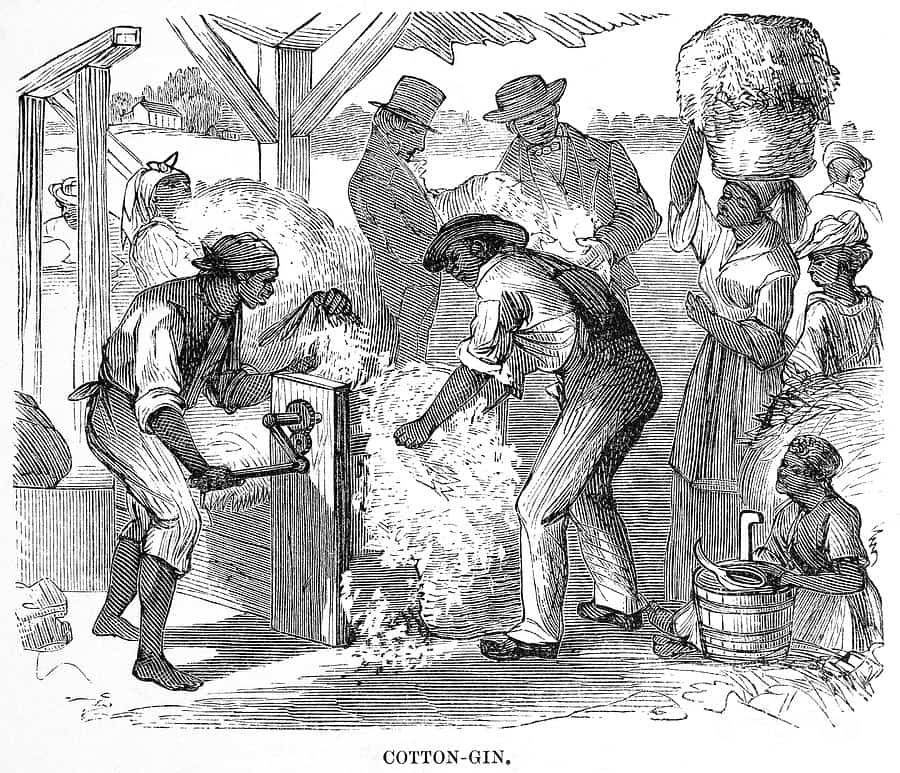
Enslaved Africans working with a cotton gin
- Southerners knew that if they were to leave the Union, the North had an overwhelming advantage in terms of population and wealth.
- However, with the Cotton Boom, Southerners felt optimistic about their future.
- To pro-secessionists in the South, seceding from the Union was feasible because of the economic development brought by the cotton industry.
- The Cotton Boom may have had its advantages in terms of the rise of the economy in the South, but it also had its disadvantages, specifically when it came to slavery.
- When Whitney’s cotton gin was created, many thought that it would reduce the need for enslaved people since the machine could replace human labour.
- In reality, the increase in production of cotton would increase its demand; thus, more enslaved people were needed to make and export more cotton to meet the demands.
Background to Slavery of Africans
- No idea was more central in the United States than the idea of freedom; and yet in the beginning, it had an institution quite the contrary of freedom: slavery.
- Enslaved Africans were used to work on cotton plantations.
- Although there were Native Americans, they weren’t enslaved as they were new to being exposed to diseases, were close to their homes and could escape easily, and had political allies that could fight against enslavers.
- Africans, however, had more experience working on crop productions back in Africa.
- They were also less likely to get sick.
- Furthermore, possibilities of them escaping were low as they were unfamiliar with the land, had no allies, and — as racist as it sounds — the whites preferred them for their visible skin colour.
- Cotton production, despite the creation of the cotton gin, required land and labour. Land was expensive so the Southerners had to find a way to save more money. They resorted to slavery as it was a cheap form of labour.
- Enslaved people weren’t paid money but only given food and shelter — this was also limited as it depended on their enslavers.
- As the Southerners saved money through enslaved people, they were able to invest more in their business.
- The other potential of enslaved people to the cotton economy was that the children of enslaved African women would be born into legal slavery.
- This would give enslavers a long-time supply of free labour through the generations.
- The enslaved population was not merely a necessity; they were also a symbol of success.
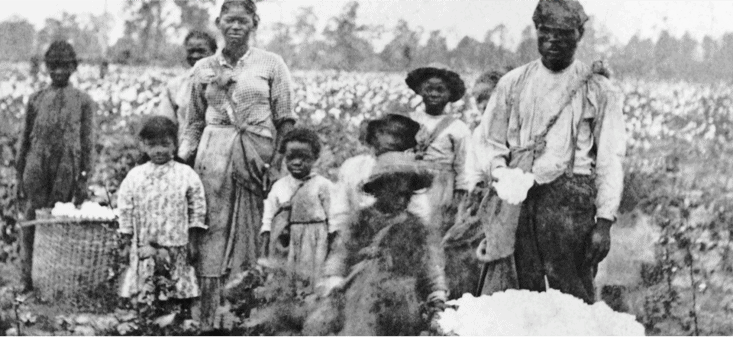
The Hierarchy of Workers in the South
- In the South, there existed a hierarchy of workers.
- The upper class consisted of the elites who were owners of larger cotton plantations with more enslaved people.
- Below the upper class were the smaller farmers with smaller plantations and fewer enslaved people. They were fiercely independent.
- At the bottom of the hierarchy were the small farmers without enslaved people. They made up only three-quarters of the white population.
- From this existing hierarchy, it is clearly seen that farmers who dreamt of increasing their profits, as well as their status in the South, would need to purchase more enslaved people.
- Nonetheless, these class tensions among the whites could never reach up to the class tensions with the blacks who weren’t even considered members of the community.
- Moreover, these tensions were eased by the whites’ belief that they belonged to a “superior race”.
Cotton and Slave Trade
- The Congress technically abolished foreign slave trade in 1808; however, since the cotton industry needed enslaved people, many Americans continued to smuggle enslaved people across the Atlantic Ocean.
- The domestic slave trade was also on the increase caused by the abandonment of farming by the earlier states of Virginia and Maryland; thus, enslaved people were either freed or sold.
- Free African-Americans, especially children, were often in fear of being kidnapped and sold to slavery.
- Even when all the Northern states outlawed slavery by 1820, King Cotton made enormous profits so that the idea of having more enslaved people became irresistible to the white Southerners.
- Between 1790 and 1859, white farmers sold 1.5 million enslaved people from Virginia to the Southern states to clear the land in preparation for cotton farming.
- During the westward expansion, many plantation owners would abandon their land for new and fresh land every ten to fifteen years, having exhausted the soil at the former property.
- During March and April, cotton was planted and enslaved people would carefully tend to the crops from April to August.
- By August, the plants had flowered and began to form cotton bolls.
- During harvest, enslaved people worked to fill sacks, under the supervision of a white master with a lash to maximise the daily outputs of the enslaved people.
- The white enslaver expected the enslaved people to pick two hundred pounds of cotton in a day and work ten acres of land with only a ten-minute rest.
- Feeding the enslaved people undermined profits; therefore, farmers gave them very little food to eat.
- Some farmers provided the enslaved people with enough food to increase their productivity.
- In the evening after work, enslaved people still had to take care of their own animals and small farms, which they needed to supplement their dietary needs.
- The further south, the harsher the conditions were.
- Enslavers threatened their enslaved people that if they tried to escape they would be sold down the river.
Conclusion
- After the invention of the cotton gin, the demand for cotton increased.
- By the start of the Civil War, 75% of the world’s cotton was produced by the South.
- Historians even say that if the Confederacy (Southern states or states that had seceded from the Union) was a separate nation, they would have been the fourth richest in the world because of the demand for cotton.
- This upsurge of demand needed an upsurge in production; hence, a necessity for slave labour.
- As the economy of the South grew, enslaved people became so entrenched in it that not even the belief that all men were created equal could extricate them.
Image sources:

